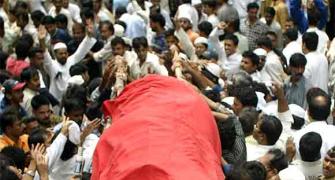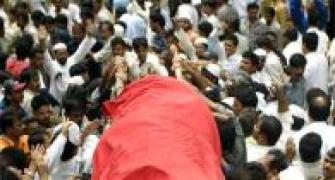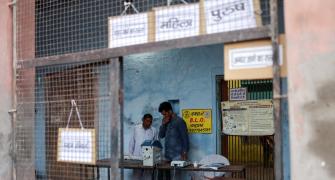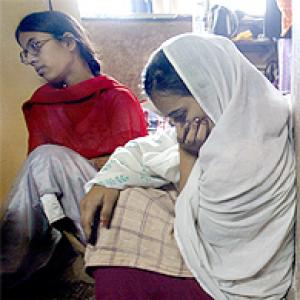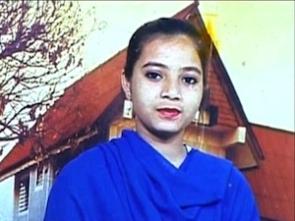 The Intelligence Bureau and the Central Bureau of Investigation are at loggerheads over the Ishrat Jahan encounter case. Last Thursday, CBI director Ranjit Sinha claimed the agency has sufficient evidence against Intelligence Bureau special director Rajendra Kumar for his alleged involvement in the 2004 encounter of Ishrat Jahan and three others.
The Intelligence Bureau and the Central Bureau of Investigation are at loggerheads over the Ishrat Jahan encounter case. Last Thursday, CBI director Ranjit Sinha claimed the agency has sufficient evidence against Intelligence Bureau special director Rajendra Kumar for his alleged involvement in the 2004 encounter of Ishrat Jahan and three others.
While the IB is trying to protect its officers, the CBI is no mood to buckle down. “We will act against any person involved in this case irrespective of his position,” said the CBI.
The recent developments have once again raised THAT pending question: Was the encounter fake?
Rediff.com’s Vicky Nanjappa takes a re-look at the controversial case.
On June 15 2004, four persons, including a 19-year-old college girl Ishrat Jahan, were gunned down by the crime branch of the Ahmedabad police who branded them as “Lashkar-e-Tayiba operatives planning to assassinate Gujarat Chief Minister Narendra Modi”.
The three others killed were identified as Pranesh Pillai (alias Javed Gulam Sheikh), Amjad Ali Rana and Zeeshan Johar.
The encounter was led by the then Deputy Inspector General of Police D G Vanzara, who is also an accused in the Sohrabuddin Sheikh fake encounter case. Known to be close to Modi, Vanzara and the entire Gujarat police came under fire for the killing of Jahan after her mother said she was the victim of a “fake encounter.”
However, a news report published in the Lahore-based Ghazwa Times, considered to be a mouthpiece of the LeT, claimed that Jahan was its operative. But soon after Jamat-ud-Dawa, the political wing of the Lashkar, immediately clarified the report as a journalist error and apologised to Jahan’s family.
Independent inquiries were set up and the probe dragged on for nearly five years. It was alleged that political influence slowed down the investigation.
In the 2009, the Ahmedabad metropolitan court held that the encounter was staged. The Gujarat government faced pressure from Maharashtra, since Jahan hailed from Mumbai. According to the Maharashtra police, she had no criminal background. Samajwadi Party leader Abu Azmi demanded a CBI probe in the encounter and after much deliberation the government handed over the case to the investigating agency.
The investigations continued, but the Gujarat government stuck to its stand that the encounter was genuine. This was corroborated by Pakistani American terrorist David Coleman Headley, involved in the 26/11 Mumbai terror attacks case. He reportedly told the National Investigation Agency that Jahan was indeed a LeT fidayeen. But the NIA rubbished reports that Headley spoke about Jahan.
An NIA letter produced in the Gujarat high court in May 2011 by the central government's counsel Pankaj Champaneri, said, “Aversion made regarding David Colman Headley making statement on Ishrat Jahan is purely in the nature of hearsay, it does not have any evidentiary value."
As the investigation in the case progressed more allegations were made against the Gujarat police. According to People's Union for Civil Liberties, a human rights’ body, the Gujarat police did not follow normal procedures in their investigations. No FIR was lodged with the local area police station where the encounter occurred; no chargesheet was filed. There was no inquest report and no witness statement.
Before the case was handed over to the CBI, a judicial inquiry headed by Metropolitan Magistrate S P Tamang was constituted. The report stated that four persons were killed in police custody. Further, it was stated that some top officers were assured promotions for such fake encounters.
The report named Vanzara as the accused in the case while stating that Jahan and three others were kidnapped on June 12, 2004 and were killed two days later in police custody. The police were accused of shooting the victims after their death to show that it was an encounter. The report also accused the police of planting weapons to prove that they were terrorists. The report implicated Vanzara and his deputy Narendra Amin, Kaushik K R, the then commissioner of police (crime branch) P P Pandey and Tarun Barot, an encounter specialist.
The Gujarat government challenged the report before the high court on the ground that the accused were not accorded an opportunity to present their side of the case. The court stated that the encounter case was of national importance and ordered the police witnesses to be placed where they would not be working as subordinates to officials accused in the case.
Following this, a Special Investigating Team was set up and this team told the HC in 2011 that the encounter was fake. The HC ordered that a complaint under Indian Penal Code Section 302 (murder) has to be filed against those involved in the fake encounter.
After the high court order, the CBI came into the picture. The CBI arrested Gujarat IPS officer G L Singhal, who was then the assistant commissioner of police (crime branch) on February 21. In its FIR, the CBI stated that Singhal had played a crucial role in the fake encounter.
On June 4, Vanzara was arrested by the CBI from Sabarmati Central Jail in Ahmedabad where he was lodged as an accused in the Sohrabuddin case.
And now on its radar is IB officer Rajendra Kumar. According to the investigating agency, it has witness testimony and call data records to prove that Kumar was part of the conspiracy to eliminate Jahan. It plans to interrogate Kumar.
The CBI also alleges that an IB officer supplied weapons, which were planted on Jahan and the three others killed in the encounter.
While the CBI says that it has a very strong case on hand, the IB argues that its job is to provide inputs, but the operational power does not lie with it. The IB does not tell the police to carry out an encounter, an officer said.
With the CBI and the IB at war today, will the whole truth ever come out?
Image: Ishrat Jahan was killed in an encounter by the Ahmedabad police in June 2004

